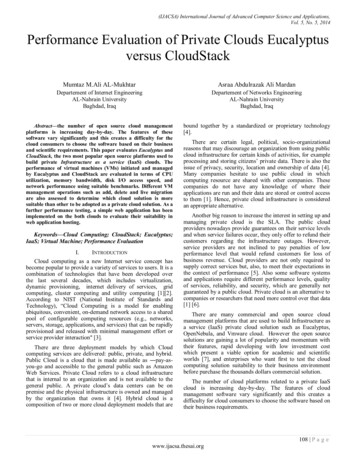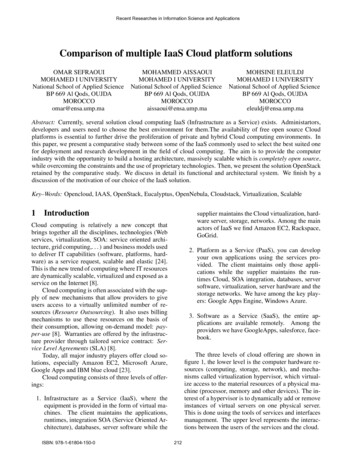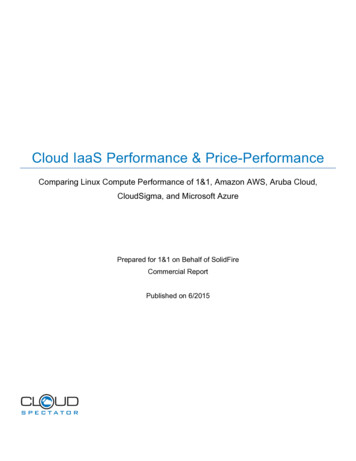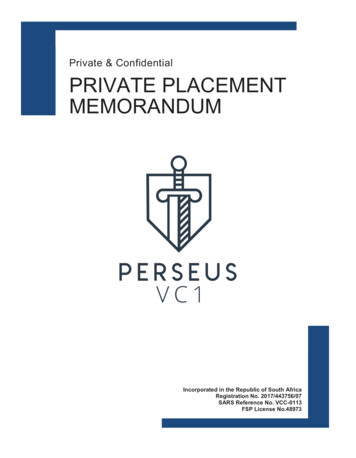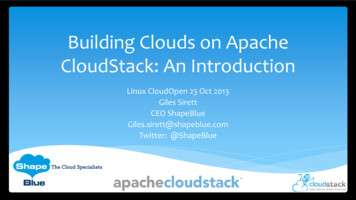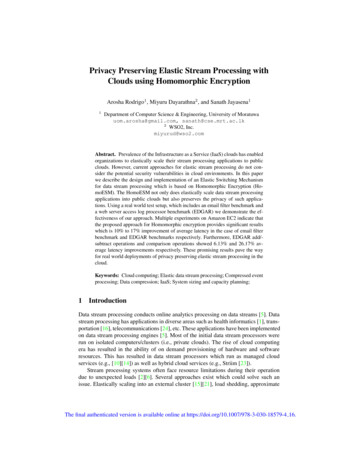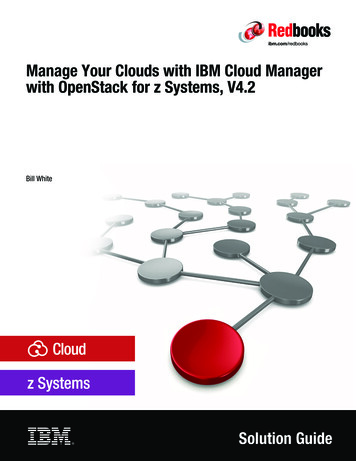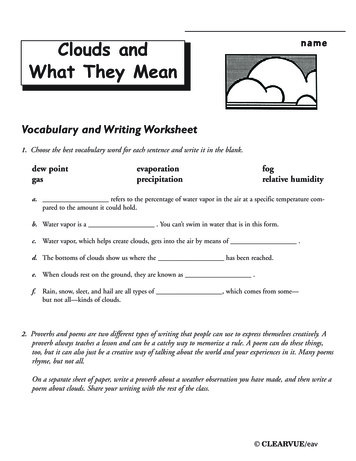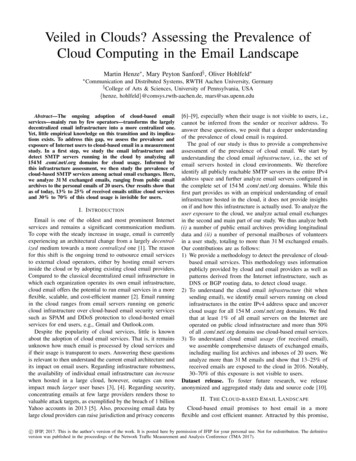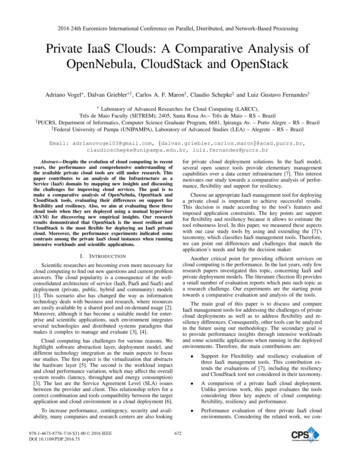
Transcription
2016 24th Euromicro International Conference on Parallel, Distributed, and Network-Based ProcessingPrivate IaaS Clouds: A Comparative Analysis ofOpenNebula, CloudStack and OpenStackAdriano Vogel , Dalvan Griebler † , Carlos A. F. Maron† , Claudio Schepke‡ and Luiz Gustavo Fernandes† Laboratory of Advanced Researches for Cloud Computing (LARCC),Três de Maio Faculty (SETREM), 2405, Santa Rosa Av.– Três de Maio – RS – Brazil† PUCRS, Department of Informatics, Computer Science Graduate Program, 6681, Ipiranga Av. – Porto Alegre – RS – Brazil‡ Federal University of Pampa (UNIPAMPA), Laboratory of Advanced Studies (LEA) – Alegrete – RS – BrazilEmail: adrianovogel03@gmail.com, ioschepke@unipampa.edu.br, luiz.fernandes@pucrs.brAbstract—Despite the evolution of cloud computing in recentyears, the performance and comprehensive understanding ofthe available private cloud tools are still under research. Thispaper contributes to an analysis of the Infrastructure as aService (IaaS) domain by mapping new insights and discussingthe challenges for improving cloud services. The goal is tomake a comparative analysis of OpenNebula, OpenStack andCloudStack tools, evaluating their differences on support forflexibility and resiliency. Also, we aim at evaluating these threecloud tools when they are deployed using a mutual hypervisor(KVM) for discovering new empirical insights. Our researchresults demonstrated that OpenStack is the most resilient andCloudStack is the most flexible for deploying an IaaS privatecloud. Moreover, the performance experiments indicated somecontrasts among the private IaaS cloud instances when runningintensive workloads and scientific applications.I.for private cloud deployment solutions. In the IaaS model,several open source tools provide elementary managementcapabilities over a data center infrastructure [7]. This interestmotivates our study towards a comparative analysis of performance, flexibility and support for resiliency.Choose an appropriate IaaS management tool for deployinga private cloud is important to achieve successful results.This decision is made according to the tool’s features andimposed application constraints. The key points are supportfor flexibility and resiliency because it allows to estimate thetool robustness level. In this paper, we measured these aspectswith our case study tools by using and extending the [7]’staxonomy, which classifies IaaS management tools. Therefore,we can point out differences and challenges that match theapplication’s needs and help the decision maker.I NTRODUCTIONAnother critical point for providing efficient services oncloud computing is the performance. In the last years, only fewresearch papers investigated this topic, concerning IaaS andprivate deployment models. The literature (Section II) providesa small number of evaluation reports which puts such topic asa research challenge. Our experiments are the starting pointtowards a comparative evaluation and analysis of the tools.Scientific researches are becoming even more necessary forcloud computing to find out new questions and current problemanswers. The cloud popularity is a consequence of the wellconsolidated architecture of service (IaaS, PaaS and SaaS) anddeployment (private, public, hybrid and community) models[1]. This scenario also has changed the way as informationtechnology deals with business and research, where resourcesare easily available by a shared pool and on-demand usage [2].Moreover, although it has become a suitable model for enterprise and scientific applications, such environment integratesseveral technologies and distributed systems paradigms thatmakes it complex to manage and evaluate [3], [4].The main goal of this paper is to discuss and compareIaaS management tools for addressing the challenges of privatecloud deployments as well as to address flexibility and resiliency differences. Consequently, other tools can be analyzedin the future using our methodology. The secondary goal isto provide performance insights through intensive workloadsand some scientific applications when running in the deployedenvironments. Therefore, the main contributions are:Cloud computing has challenges for various reasons. Wehighlight software abstraction layer, deployment model, anddifferent technology integration as the main aspects to focusour studies. The first aspect is the virtualization that abstractsthe hardware layer [5]. The second is the workload impactand cloud performance variation, which may affect the overallsystem results (latency, throughput and energy consumption)[3]. The last are the Service Agreement Level (SLA) issuesbetween the provider and client. This relationship refers for acorrect combination and tools compatibility between the targetapplication and cloud environment in a cloud deployment [6].To increase performance, contingency, security and availability, many companies and research centers are also looking978-1-4673-8776-7/16 31.00 2016 IEEEDOI 10.1109/PDP.2016.75672 Support for Flexibility and resiliency evaluation ofthree IaaS management tools. This contribution extends the evaluations of [7], including the resiliencyand CloudStack tool not considered in their taxonomy. A comparison of a private IaaS cloud deployment.Unlike previous work, this paper evaluates the toolsconsidering three key aspects of cloud computing:flexibility, resiliency and performance. Performance evaluation of three private IaaS cloudenvironments. Considering the related work, we con-
[9] and [3] analyze usefulness and performance of scientific applications for current cloud computing services. Theyanalyzed Amazon EC2 platform using micro-benchmarks andsynthetic kernels. The results indicated current public cloudservices need performance improvements for scientific applications. Also, [3] concluded performance is a challenge forcloud environments due to resource sharing.tribute with OpenStack performance view and scientific applications insights for these cloud pools.Our paper is organized as follows. Section II discussesthe closest related work. Section III performs a survey andmeasures IaaS tool’s flexibility and resiliency. Section IVpresents the performance experiments and analyzes the results.Finally, Section V provides the conclusion of the paper.II.The goal in [11] was to evaluate HPC applications inthe main public cloud providers, considering performance,cost efficiency and development. The article suggests cloudcomputing as an alternative for eliminating the maintenance ofstandard clusters. They ran NAS benchmarks for evaluating development and cost-effectiveness. The results show that cloudsare a viable to run HPC applications with some developmentdisadvantages such as the support for libraries. Consideringperformance and the cost-effectiveness, the authors estimatedcloud environments 27% and 41% more efficient than clusters.R ELATED W ORKThe related work is classified in tool features evaluationand performance analysis.A. Surveys for Tool FeaturesIn this section, we investigate papers concerning the evaluation of IaaS cloud features.Regarding cloud infrastructure provision and web hosting,[8]’s paper proposed a taxonomy to identify and classify cloudcomputing aspects (service type, resource deployment, hardware, runtime tuning, security, business model, middleware,and performance). They considered seven IaaS, Web hostingand PaaS providers.The paper also introduced a performancemeasurement (CPU) on cloud instances, which was continuedin [9], using a larger number of applications and test scenarios.The results emphasized the weak performance (with variations)and SLA support on cloud providers.[5]’s paper studied six IaaS public providers using standardbenchmark applications. The objective was to analyze performance and scalability variations when a multi-tier applicationis migrated from a traditional data-center environment to acloud infrastructure. Also, they evaluated the performance onthree mainstream hypervisors: XEN, KVM and CVM. Theresults show significant performance variations among thehypervisors. More precisely, Xen outperforms the commercialhypervisor (CVM) by 75% on the read-write RUBBoS workload and the commercial hypervisor outperforms Xen by over10% on the Cloudstone workload.[7]’s study proposed seven conceptual layers for a management tool of cloud infrastructure. In their classification,the IaaS management layer is composed by Command LineInterface Tools, APIs, Dashboard and Orchestrator. Such services perform essential tasks (instantiate, delete, and manageVMs, monitor resources, and power management APIs) oncloud environments for users and administrators. The authorssurveyed private and public IaaS providers to demonstrate theirtaxonomy. As a result, it distinguishes support and capabilitiesfor adapting the most suitable technology.All these papers validated the benefits to assess virtualization technologies or public IaaS clouds. [11] point out HPCchallenges and usage on public cloud computing. By the otherhand, [9], [5] and [3] contributed for public IaaS cloud providerperformance evaluation when running scientific applications.Our work differs from these previous studies on a performance analysis for three private IaaS cloud deployments.Moreover, this paper contributes for the literature with newperformance challenges and insights when running intensiveworkloads and scientific applications.A survey of the state-of-the-art efforts was conductedby [10]. It investigated interoperability as well as practicalcloud technologies of both the cloud provider’s and user’sperspectives to enable inter-operation. They concluded thatinnovations on a virtualized network should exploit softwaredefined networking capabilities to better facilitate inter-cloudcooperation. Advanced SLA mechanisms may be needed toconstantly incorporate user feedback and customized featuresinto the SLA evaluation framework. Finally, the questionremains of how to implement cost analysis and pricing ofvarious resources in interoperable clouds.III.A NALYZING F LEXIBILITY AND R ESILIENCYThe IaaS cloud comprises different layers, as illustrated inFigure 1. At the bottom are the physical resources (hardware).Above there is a Virtual Machine Manager (VMM) thatsupports the abstraction needed for the upper layers. The VMMis a hypervisor running within the native operating system (fullvirtualization) or a hypervisor running directly in the hardware(bare metal). Also, the Virtual Infrastructure Manager (VIM)is part of the IaaS cloud tools that takes advantage of virtualresources for offering services. The main tasks of resourcesscheduler, images, networks, volumes, templates and VMsConsidering these related works, [8]’s paper provides asurvey of IaaS taxonomy for public clouds while our workconcentrates on private clouds. [7]’s work creates a taxonomyfor flexibility evaluation that we use as a baseline in our paper.On the other hand, [10]’s study provides a taxonomy for IaaSinteroperability. Therefore, we complement flexibility andcontribute with resiliency and CloudStack tool analysis.B. Experiments for Performance EvaluationFor each performance related works, we analyzed aspectssuch as objectives, execution environment, adopted workloads,numeric and qualitative conclusions and limitations.Fig. 1.673IaaS overview.
creation are performed by the VIM, which are related to virtualinstances and appliances [12]. Finally, the cloud manager canbe a part of an IaaS tool or a separate cloud layer. Thislayer controls users, groups, permissions, quotas and qualityof service issues of the cloud environment.control, management, security, and resource abstraction. Also,we extend the analysis to cover resiliency.Open source IaaS cloud tools present relevant and advancedoptions both for the cloud administrator and users. Table Ishows the IaaS tools equivalency for flexibility. We surveyedall tabulated data by deploying these tools as well as lookingfor their official documentation. As presented in the Table I, theAlmost all cloud management tools support administrativetasks through a graphical User Interface (UI), which is nameddashboard by the tool’s nomenclature. This interface is available through a web browser, providing virtual infrastructurecontrol. There is also a Command Line Interface (CLI) whichis used by cloud administrators to faster and easier terminalcontrol. The last user interactions are the APIs for controllingthe tool’s infrastructure and integrating them among differentservices. The next sections will present and discuss OpenNebula, CloudStack and OpenStack.TABLE er serviceInternalIdentity serviceSchedulingImage repositoryCharging and billingLoggingMessage busResource managementFederation managementElasticity managementCloudStack is conceptually built on stacks of services andinternal agents. The first service is the cloud controller. Thesecond is the storage server for hosting volumes. [15] Thethird service (secondary storage) is for handling ISO images,templates and snapshots. It is implemented using a distributedfile system service. The last one is a network service thatimplements several advanced features like virtual LAN, VirtualPrivate Network and Generic Routing Encapsulation [16].User/group managementSLA definitionMonitoringReportingIncident managementPower managementLease managementCLI toolsAPIsOpenStack builds on API stacks. These APIs are used tocommunicate its services using the RabbitMQ. Such messengerruns as an interface among APIs and offers infrastructureservices for the cloud system. There are forty individualcomponents available, where the essential are: orchestrator,ceilometer (metering), swift (object storage support), Neutron(networking), Keystone and hybrid support [17]. The storagemay be deployed in different ways and stored locally ordistributed. OpenStack is considered a modular and granularsolution because enables to implement individually all infrastructure services[18]. The next sections will present anddiscuss more details about the tionSecurity groupsSingle sign-onSecurity monitoringSLA enforcementSLA monitoringMeteringPolicy controlNotification serviceOrchestrationB. Flexibility EvaluationThe majority of cloud tools are robust and complex technologies. In recent years, cloud applications and usage havebeen investigated by the scientific community [3], [11], [10].The architecture and flexibility of IaaS cloud tools for acustomizable deployment are still under research [7], [8], [10].Therefore, we present a comparative analysis among threeopen source solutions to deploy an IaaS cloud. We basedour flexibility evaluation on [7]’s taxonomy which is dividedinto seven layers: core service, support, value-added services,Availability zonesHigh availabilityHybrid supportLive migrationPortability supportImage contextualizationApplication support674OpenNebulaCloudStackResource abstraction irtual NetworkInternalManagerCore service layerIAM pluginIAM tackUsageInternalInternalSupport LMySQLA. IaaS Tools in a NutshellOpenNebula software is designed to work with driverconcept for implementing the IaaS layer [13]. Those familiarwith Linux systems will feel comfortable to deploy and controlOpenNebula cloud. Mostly because it does not create a propernomenclature, integrating default Linux-based services likescripts and components. When building a cloud environment,a machine must be configured as front-end, which will host thecloud manage, and all the other machines will be slave nodes.Storage, virtual machine, data transfer, network management,and job scheduler are configured by OpenNebula servicesmanagement, using a compatible technology [14].T OOL’ S FLEXIBILITY.InternalManagement layerInternalInternal//Auto-scalingElastic LoadBalancingInternalInternal//probe/ssh/OneGate Externalcode lManagement toolsOpenNebula CLIcloudmonkeyPublic cloud andPublic cloudPluginsand PluginsSunstone(AdminAdmin UIUI, User UI)OneflowCloudstackCookbookSecurity layerBasic Auth/OpenSAML/LDAPNebula Auth/x509 Auth/LDAPAuth lControl layer////ExternalUsage plugin///InternalInternalInternalValue-added ntext///OpenStackNovaObject aObjectstore/cinderNova/Elastic RecheckInternal/External/ExternalBlueprint driverExternalOpenStack (CLI)Public cloud ternalInternalExternalHP Helion/Amazon EC2/IBMInternal///
IaaS solutions have different features and goals. Some featuresare supported inside the core solution (“internal”), others easyachieve the demand when integrating with an external and fullycompatible component/framework (“external”), while a few arenot supported (“/”).to a set of users or projects sharing affinities and privileges.The single sign-on is related to the identities sharing andauthentication among distinct/independent systems. Finally,the security monitoring is a complex system that managesand works based on predefined actions to maintain elevatedsecurity levels (authorization, high availability, among others).Despite the general poor security monitoring and single signon (only CloudStack supports), the tools enable authentication,authorization and security groups for increase the privacyand isolation. These insights are basic security aspects whichdemonstrates open challenges for OpenStack and OpenNebulato integrate security monitoring and deal with single sign-on.The resource abstraction layer is the closest to the virtualization. OpenNebula uses the Oned to provide computerresources (CPU, memory). OpenStack takes advantage of theNova API to process compute requests, which have advancedtasks/resources like scheduling and networking. CloudStackuses the libcloud for attending the tool’s services. On thestorage and volume, while OpenStack uses specific components, OpenNebula and CloudStack embedded it internally. Incontrast, just CloudStack handled itself the network feature.Considering that all tools are proving at least some resourceabstraction, they have similar flexibility on this layer.The control layer presented a weak coverage of the tools.The poor SLA support indicates that they are most suitablefor private cloud instead of public cloud. The metering serviceis for monitoring users’ cloud utilization. CloudStack has theadvantage of offering a notification service, facilitating thecloud administration. The policy control feature is a set ofcapabilities related to security and quotas. Through our studieswas possible to find out their no support in this category.The orchestration system is for enabling easy integration ofservices, being internally implemented.In the core service layer, the identity service is used oncomplex cloud deployments to guarantee authorization. Forexample, OpenStack keystone API manages all its componentsand users while other tools uses an external plugin or manages it internally. The scheduler prepares all the managementjobs according to the resources availability and load balance,where each one have its own scheduler. The image repositoryprovides a catalog of pre-built OS ISOs to facilitate the VMslaunching. All tools enable charging and billing services. Suchfeature is useful for public cloud providers to control thetenants resources usage. The logging are stored internallyin plain text files or database. Thereby, specific tools arenecessary to audit them.The last layer is the value-added, wh
ula, CloudStack and OpenStack. A. IaaS Tools in a Nutshell OpenNebula software is designed to work with driver concept for implementing the IaaS layer [13]. Those familiar with Linux systems will feel comfortable to deploy and control OpenNebula cloud. Mostly because it does not create a
